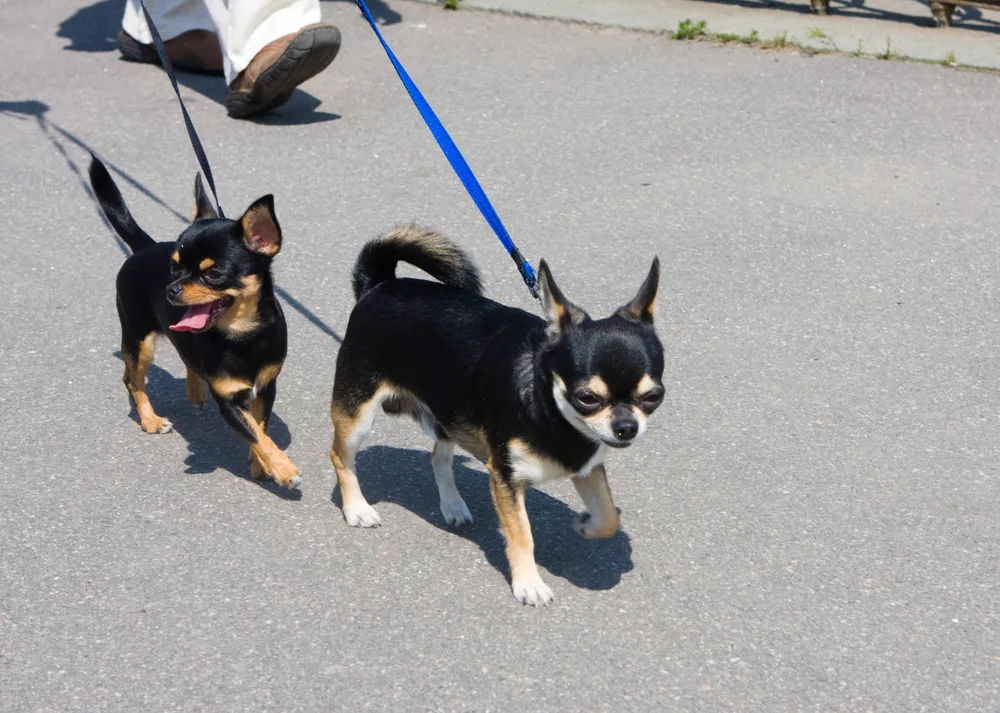Have you ever wondered if your Chihuahua is getting the right amount of exercise? Is your chi happy with the amount of time he or she is spending under the sun? Or, maybe you’re a pretty athletic dog owner and you’re curious if your pooch can keep up with you in your daily 2 mile runs.

If you’ve had these thoughts, don’t worry. In this article, you’ll hopefully gain a better understanding of how much exercise is appropriate for your chihuahua.
Remember, regular walks are important for your pup’s health, but too much can strain their body, so having this knowledge is handy to know.
Factors To Consider In Determining Walk Duration
For healthy dogs, several important factors helping to determine their daily dose of walking include:
(a) their breed,
(b) their age,
(c) any medical conditions they have, and
(d) their accustomed fitness level.
As a simple reference point, for most chihuahuas, about 30 minutes of exercise per day is wonderful. Sometimes they can go beyond that, but it can be best to slowly work up to a longer amount.
Usually, however, 30 minutes is a good starting amount for new chi parents.
Breed
Certainly, a dog’s breed plays a huge role in how much daily walking might be needed. For example, a working dog like a border collie could use hours of exercise per day, while a couple of hours of exercise for a pug or a chihuahua would result in an all-day nap right afterward!
Chihuahuas are the smallest breed of the dog kingdom. They weigh 2-6 pounds and can grow 6-9 inches tall. Similar to bichons and shih tzus, to name a few, chihuahuas require less exercise compared to larger breeds that require 60-120 minutes or more of exercise daily.
Though, know that despite their miniature size, chihuahuas are unbelievably vivacious dogs. While being naturally energetic and seeking physical play often, chis are also known as lovable lap dogs. If you’re going to get one, be ready to pound the pavement on a daily basis, or hire a dog walker, to satisfy these lively dogs’ craving for fun activities.
So, one thing’s for sure, your Chihuahua is made for physical activity, though it probably won’t be more than a couple of 30-minute sessions per day; exercise should be part of their daily routine, whether that consists of a walk around the block or backyard playtime.
Age
Your dog’s age directly affects their ability to exert physical effort and their need for consistent exercise.
Just like humans, dogs slow down when they enter a certain stage of maturity. Similarly, just like toddlers, puppies need a decent amount of exercise to build up their strength.
Your dog’s 1st birthday implies an approximate human age of 15 human years, and your pup’s 2nd birthday equates to about age 24! Just 6-7 years later, your chi will officially be a senior. So, what does this mean in terms of their ability to walk long distances?
Puppies
Before anything else, you should remember that it’s not recommended that you take your puppies out for a walk without receiving their vaccinations first. Dog pathogens are everywhere. Parvovirus, for example, is a canine disease that has a fatality rate of 80 percent for puppies and it can be picked up in many public places.
Once your pup has been fully vaccinated (and you’ve followed other precautions from your vet), you should feel more comfortable taking your pup for a walk. As a rough yardstick for about the first 6 months, your puppy can tolerate up to 5 minutes of walking time per month of age.
For example, if your chihuahua is 3 months old and has received all necessary puppy shots, then 15 minutes of daily exercise should be great.

Adults
Chihuahuas stop growing physically around 10-12 months, and, during this stage, they are considered to enter adulthood.
By this point, your chi should be more capable of tolerating longer walks with fewer breaks. If you have an adult chihuahua who is perfectly healthy and strong, your chi can most likely walk with you for around 30 minutes if not more, once or twice a day.
Seniors
Regardless of age, exercise is truly a daily necessity, even for senior dogs. Despite changes in their energy levels and mobility, dogs’ love for walking hardly changes, even through their senior years. In fact, your pup will most likely show the same level of excitement as before when they see the leash.
Did you know that a 10-year old chihuahua is equivalent to a 56-year old human? You read that right! Dogs biologically age faster because they have a shorter lifespan. On average, a human can live up to 80 or more years while dogs have an average lifespan of 10-13 years, depending on the breed (chihuahuas can live up to 18 years or more).
One implication is that deterioration and old-age conditions come quicker for dogs. Though, this only underscores the need for daily exercise, since it’ll undoubtedly extend your dog’s lifespan, and their strength to fight off negative health conditions.
You can walk your senior dog at shorter intervals. This means that your dog, even at an old age can still finish a 30-min stretch, but with more breaks. If you’re unsure of your dog’s physical condition and capabilities, it’s a great idea to consult your vet and talk to other owners who are going through the same stage of parenting.
Medical Conditions
One question is, “can my dog still perform physical activity, despite medical conditions?” The answer is, fortunately, usually, yes.
Chihuahuas are prone to some diseases including luxating patellas, hip dysplasia, and heart problems among others.
In most cases, these conditions prohibit them from strenuous physical activities such as long walks, and in this case, it’s best to get your vet’s opinion on what amount of exercise is best. This also applies to some medical conditions like luxating patellas.
If anything else, one recommended method is to divide one walking session into multiple segments. You can divide a 30-minute walk into a series of shorter walks throughout the day. This way, less added stress or damage is done to their joints.
Some conditions like Intervertebral Disc Disease (IVDD) can really put a limit on a dog’s physical capabilities. IVDD is an age-related condition that affects the spine of dogs that causes muscle spasms and weakness in their hind legs, which often afflicts dogs such as dachshunds. In some cases, conditions like IVDD can put a shorter cap on some dogs’ walking time. If such conditions exist, your veterinarian can also help you create an exercise program suitable for your pet.
Fitness Level
If you chi is not used to prolonged physical activities, it may be best to start with shorter lengths of walks. Jumping right into prolonged walks may lead to injuries such as wear-and-tear on their paw pads, stifle pain, and stress which can all lead to negative health conditions.

30 minutes is the ideal length of a daily walk, but a dog that has never been exposed to a daily exercise routine might not be able to keep up. Like senior dogs, it’s best to divide a walking routine into shorter segments to accommodate the low endurance levels caused by inactivity.
Your Observations Are Important
At the end of the day, these guidelines are merely practical advice. Your vet and you undoubtedly know your dog best. Plus, as you’re studying how much walking is best for your dog, it’ll help if you get some feedback from your dog as well! For example, if your chi wants to get picked up halfway through your walk, it may be best to shorten the walk length.
Here are some other questions, which your dog’s own feedback will be helpful in answering:
When Is A Long Walk Too Long?
If you overexert your Chihuahua, chances are you’ll start noticing panting and slowing down. These are the first signs you’ll notice.

As the saying goes, “A tired dog is a good dog.” But pushing your dog over its limits may have negative effects on him in the long run. Signs of an overly exhausted dog may include panting, slowing down, lack of interest in the activity, stopping while walking. In some cases and worst-case scenarios, your pet can also experience paw pad wear-and-tear and joint problems.
How To Know If Your Dog Lacks Exercise
It’s pretty easy to spot a Chihuahua that does not exercise enough. They are destructive, restless, hyperactive and they’ll often release their pent-up energy through barking and other sorts of attention-seeking.
Conclusion
In summary, daily walking of about 30 minutes (possibly twice per day for a healthy, active chi), is a good amount for an adult chihuahua. Though, if your chi is very young or old, or has medical conditions, then you’ll probably want to shorten that amount based on your vet’s advice, online research, and the tips from this article.
Hopefully, this article has helped to shed light upon how long you should walk your chi; to learn more about chihuahuas, please keep reading more from this blog, or you can visit our friends at Spot Dog Walkers.

Cindy & Buffy
Sunday 23rd of January 2022
Incredible teamwork! Great for Ziggy to help him back to mend. That helps your worry because when our babies are in need we just can't cope. Bless you & Ziggy on his speedy recovery as beloved Lucy will certainly ensure❣
❤ Cindy & Buffy
Cathy
Sunday 23rd of January 2022
Thank you Cindy and Buffy too!